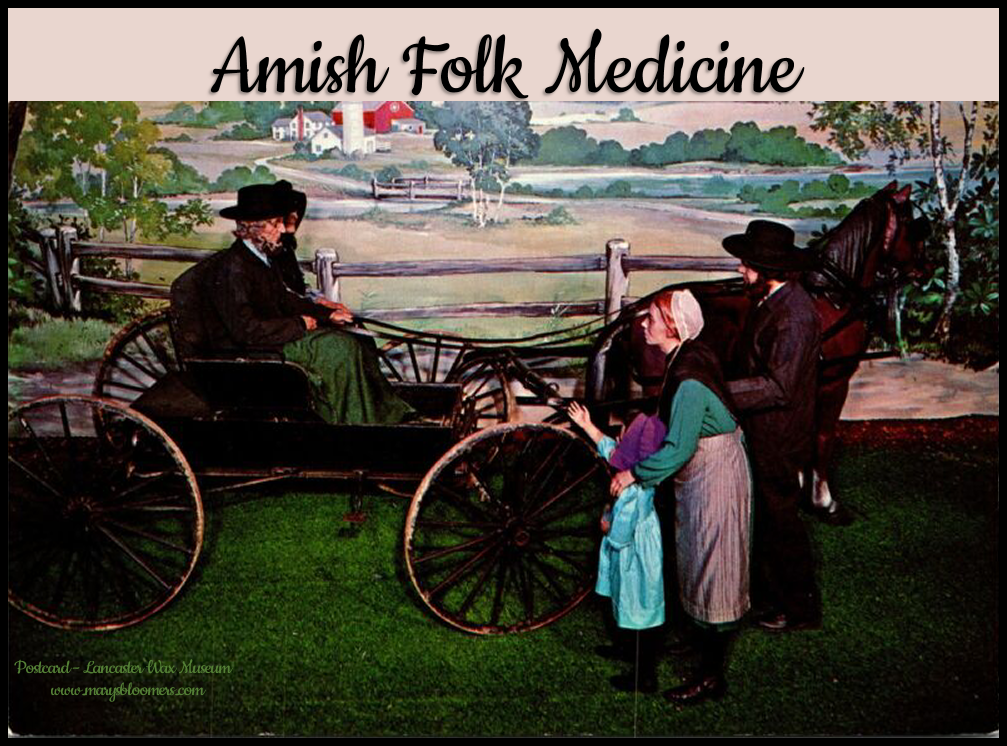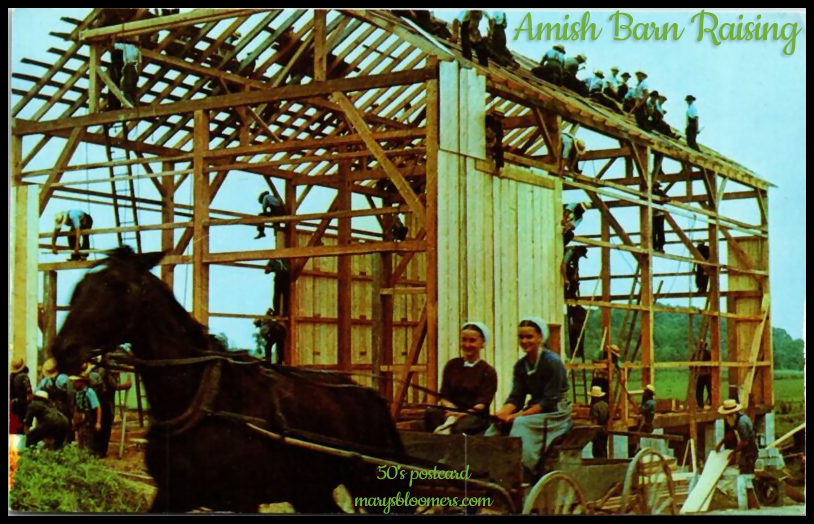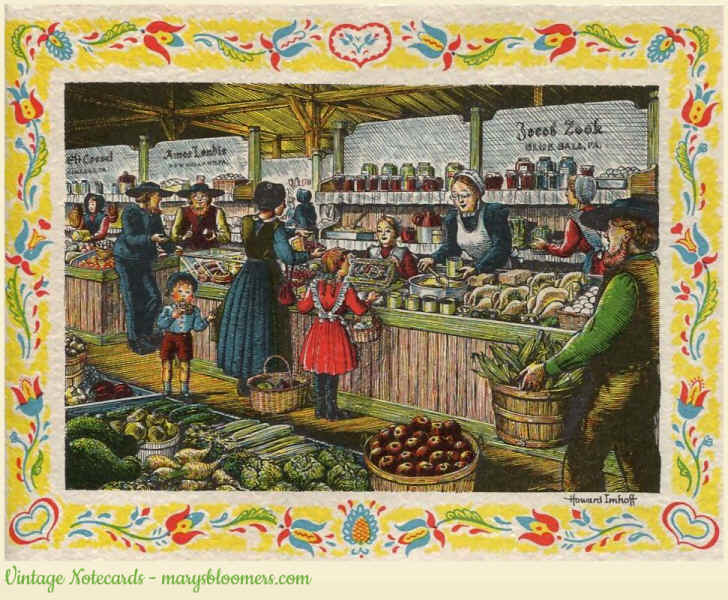|
Amish households often have elaborate herb gardens both for culinary
and medicinal purposes. Natural remedies and treatments are common throughout Amish community.
How the Amish approach medical treatment and wellness can depend on the
specific Amish group, community or family, and personal preference.
Because "Plain" communities originate from relatively small
populations, they experience a high level of certain diseases not often
seen in the wider population. And certain diseases that are
present in the wider population, are virtually non-existent in Plain
communities.
Deep ties to agrarian culture have given the Amish a valuable and
in-depth knowledge of natural, restorative medicines derived from plants
and medicinal herbs. Today, Amish herbal remedies and natural cures are
highly sought after by "outsiders". Amish folk remedies
include a combination of holistic healing techniques, including
traditional German medicine, traditional Chinese medicine and
traditional Native American medicine. Hot springs and herbal remedies
are also popular among Amish people who suffer from arthritis. Fresh air
is one of the most important natural remedies practiced daily. The Amish
are hard-working farmers. Fresh air and exercise are natural to them.
Homes are regularly aired out to keep the indoor environment fresh and
free from those things that are a danger in a consistently closed off
and stagnant environment.
The tradition of Amish herbal medicine has been practiced and handed
down for more than three centuries, both for the tradition of
self-sufficiency of the Amish culture, and its avoidance of the outside
world. The Amish seek out professional medical treatment only when
suffering from a serious condition. Because most Amish men complete only
an 8th-grade education, there are few licensed medical practitioners
within the faith.
There is no religious reason not to seek medical care for the
majority of Amish communities.
Some groups limit their interaction with
modern world, which includes physician consultation.
Transportation distances also limit the Amish from seeking modern
medical treatment. "Plain people" often advocate for more
freedom in deciding when to go to a hospital, how to get there, and what
interventions will be used. Autonomy in health care is deeply tied
to personal responsibility. This is exemplified by their choice
not to have insurance. When someone gets sick, the church collects alms
to help the patient cover expenses. They believe a profit motive can
influence courses of treatment. In the Amish world, healthcare is seen
as a ministry.
Plain people think there’s a lot of harm in divorcing the cost from
the patient. There are Amish communities in which individuals are
beholden to their brothers and sisters in the church to make wise
healthcare decisions that don’t cost the community more money than
necessary. As a result, Plain communities are highly interested in
health education and disease prevention. They want to know how diseases
develop and what they can do themselves to prevent a disease or its
progression.
They are excellent patients - It is
said that they want to do whatever they
can, whether it’s eating better or exercising more, to improve their
conditions and lessen their reliance upon medication. The Amish do not
partake in Social Security benefits, Medicaid, Medicare or Obamacare.
Plain people don’t sue for malpractice. The Amish understand that
doctors are human and make mistakes. They work together with their
doctors, combining natural and traditional medicine for healing.
Designing an Amish Medicinal Garden
An Amish medicinal garden can contain herbs
like Goldenseal, Licorice and Valerian.Medicinal herbs used by the Amish
can be grown in your herb garden or vegetable patch. You can grow
individual herbs in rustic clay pots. It's a great look. so is
interspersing the flowering herbs within your ornamental flower garden.
What to grow: Chamomile, feverfew, coneflowers
(echinacea), goldenseal, valerian, skullcap, aloes, bittersweet, hops,
onions
raspberries, strawberries, huckleberries, hawthorne, elderberry,
grapevines, comfrey, peppermint.
Decorate it
It's not something that the Amish would tend to do, but unless you
are Amish and have restrictions on ornamentation, feel free to add
folkart pieces to the medicinal garden, and a seating area for you to
enjoy and relax within your healing space. Pennsylvania Dutch folkart is
quite colorful.
Use clay pots in all shapes and sizes to plant your herbs.
Use pots in primary colors that you see used in Amish and Pennsylvania
Dutch Folkare Designs
Decorate with vintage toleware pots, pitchers, kitchen utensils,
buckets, hex signs or quilt designs.
Hang barn stars in different sizes from tree branches, on the sides of
structures, hang from a porch roof or railings, hang from gates, nail
onto mature trees or nail to large stumps.
Use bushel, berry and other rustic baskets, firkins, picnic hampers.
Other metalware - use granite or enamelware containers, bowls, pitchers,
and other kitchen items.
Hang old farm and garden implements, like rakes, saws, shovels -
hang as rusty implements, or paint them in the colorful Dutch colors.
Place an old wheelbarrow or two as centerpieces in the garden filled
with flowers or herbs. Fill with colorful autumn leaves, winter squash
and small pumpkins or gourds for an autumn display.
Natural remedies frequently used by The Amish
***These natural and home remedies are given for
information use only, as a guide to the natural remedies used by the
Amish.
They are not given as prescriptions or suggested remedies for your
ailments.
If you are ill, see your physician.
If you use any of these remedies, you do so at your own risk.
Many Amish herbs for healing can be grown in your garden,
in pots, window boxes and on windowsills, or they can be foraged from woods and roadsides.
Aloe can easily be grown as an indoor plant, and kept handy in
kitchens and bathrooms as first aid.
Honey the Superfood and A Common natural
remedy
Honey is a globally used and celebrated superfood and it is
a natural antibacterial and antiseptic.
In Amish folk medicine, it is used to help control high blood pressure
- consume 1 teaspoon of honey with each meal.
This can also help those with anxiety problems.
For a nighttime cough, use 1 teaspoon of honey before bed.
People who suffer with insomnia can take 1 tablespoon of honey, alone or
in a cup of water, before bedtime.
Honey can also be used to soothe minor burns. Coat the injured area
carefully, and cover with a soft cotton cloth or bandage.
Memory Booster (if you can remember the following,
you probably don't need a memory boost)
- Eat hazelnuts for 9 days beginning with 6, and adding more each day.
- Eat green pepper seeds for 9 days, beginning with 1 seed, and doubling
the dose until it eaches 256 seeds on the ninth day.
- Grind cloves, thin long peppers, dates, in equal quantities. Beat
them with olive oil into a paste. Eat a little every morning before
breakfast.
Feverfew
Very pretty herb that resembles white daisies - used in a tea
sweetened with honey to treat coughs, colds and flu. It is also used as an
insect repellent, made into a strong tea and then sprayed on plants. The
National Institutes For Health states that it is also used for treating
migraine headaches, rheumatoid arthritis, allergies, and other ailments.
Wild Cherry Bark
Wild cherry contains chemicals that might help reduce swelling
(inflammation). It is also used in cough syrups because of its sedative
(sleepiness), expectorant (clearing mucus), drying, and cough-suppressing
effects
Dandelion
A treatment for diabetes, as a “blood purifier and
cleanser" and for liver problems.
Dizziness
Dizziness can be relieved by drinking water with a splash of
vinegar.
Hawthorne Berry
Used by the Mennonite sect to regulate the heart rate.
Insomnia
- A tea of Valerian Root or Skullcap, works wonders. But they
taste awful. Mix with honey, cinnamon, anise or agave sweetener.
- Sit 1 teaspoon gelatin in a cold cup of water for 5 minutes,
then add 1 cup hot water. Stir until dissolved. Of this, put 2
teaspoons in a glass of water or milk. Drink after supper, this will help
induce sleep.
Burns
The most well-known Amish folk remedy is B & W (Burn
and Wound) Ointment, a treatment that uses burdock leaves. Burns are a
particular threat to the Amish community, because heating, lighting, and
cooking often involve an open flame and flammable fuels.
B&W Ointment is a mixture of honey, lanolin, olive oil, aloe vera gel,
comfrey root, and other ingredients that are applied with a dressing of
burdock leaves, and it is widely used and praised throughout the Amish
community. There are members of the community who are known as the Amish
Burn Dressers.
Other natural treatments for burns
Honey can also be used to soothe minor burns. Coat the injured
area carefully, and cover with a soft cotton cloth or bandage.
- 1/2 tsp. of powdered alum in a 2 oz. bottle of water. Wet the
bandage with this and keep it wet.
- Powdered charcoal and cornmeal, made into a poultice. Cover wound
completely and keep bandage wet.
- Apply a coat of honey to cover the wound. The idea is to seal off
the air.
- Cover thickly with aloe vera gel or the ooze from a crushed
aloe vera leaf.
Swellings and sores
1 1/2 lb. bittersweet root
1 1/2 lb. black Alder
1/2 lb. hops
1/2 lb. plantain leaves
1 tobacco plug cut in bits
Place in a pot with enough water to cover. Simmer 1/2 to
3/4 hour or longer.
Strain and squeeze out juice. Boil juice down to 1/2 the amount.
Add 1 lb. unsalted butter, 1 oz. beeswax, 1 oz. rosin, and simmer over a
slow fire until the water is all gone.
Corns and Bunions
Get rid of corns and bunions by bandaging them overnight with
slices of raw onion and old bread wetted down with lots of full-strength
vinegar.
Golden Seal Root Tonic and Echinacea (Coneflower)
Golden Seal is a valuable healing herb, used for centuries and by
several cultures, and for several ailments. I use it along with my
homegrown, dried and ground echinacea (coneflower) cones for
immunity teas in winter, as a preventive. As a remedy, you can use
Goldenseal root alone, as a hot tea when the first sign of sore throat
appears. Put 1/2 teaspoon powdered golden seal root into 1 pint of boiling
water and simmer it. This herb is also known for it's cleansing
properties, and was used in a poultice or wash for leg sores, poison ivy
rash, and shingles. Echinacea, an herb prized for its antioxidant
qualities, is sometimes used in teas together with Goldenseal. In
Amish herbal medicine, echinacea is also a remedy for a bladder infection.
To lower high blood sugar
Make a tea made of huckleberry leaves..one heaping teaspoon
of crushed or powdered leaves to one cup of boiling water. When cool
drink only one cup a day as this will lower sugar fast.
To raise low blood sugar: Make a tea of grape
leaves, tame or wild. If using tame leaves, use 4 big leaves.
Wild leaves, use 6 to 8 leaves to a quart of boiling water. When cool
drink 1 or 2 quarts a day until relieved.
Flu Prevention
Put a few red hot coals on a tin container.
Put 1 teaspoon sulphur on the hot coal. This will create fumes.
Make a round through the house with these fumes every evening for one
week.
Flu symptoms
Fever
For any kind of fever, rub apple cider vinegar on temples and
soles of feet. When body temperature is back to normal, wash off.
Tea made of powdered thyme, 1 /2 teaspoon to a cup of boiling
water.
Give in teaspoon doses till relieved.
For older people, make tea stronger. Drink 4 or 5 cps until relieved.
Stomach Flu
Mix equal parts elderberry blossoms and peppermint
leaves (crushed). Mix well 1 heaping teaspoon to a cup of boiling water.
Cover. Drink when cool. Drink 1 cup every hour till relieved.
Stomach and Bowels
1 quart water, 2 tablespoons vinegar,˝ teaspoon salt. Drink as
much of this as you can in one day.
Cold symptoms
Feverfew made into a tea, sweetened with honey to treat coughs, colds
and flu.
Chamomile
Chamomile tea is used as an Amish antidote for an asthma attack, and
it's also used to fight the common cold, sore throat and bronchitis.
It's also a well-known and globally used herb to help with insomnia and
anxiety. It's a very pretty plant, similar to white daisies and feverfew,
and looks lovely in an herb or cottage garden design.
“Super Tonic”
Garlic, horseradish root, onions, and ginger, all cured in vinegar
for six months and then strained. A teaspoonful per person, passed around
the dinner table every night, is said to keep a family healthy through the
winter. What goes into the super tonic probably varies by family and
community. It has a kick. It was strong and difficult to drink in more
than a small quantity.
Toothache
Wet a small piece of cotton with vanilla and put it on the aching
tooth
Hacking cough
Slice an onion, sprinkle a little sugar over it, put it where it
is warm, and let the juices ooze out. Then you would put one or two
drops of the ooze on some sugar or sugar cubes and place it in the mouth.
Onions are also used for congestion.
You can prepare a chest rub if you fry a chopped onion in ˝ cup vegetable
shortening or lard. When the onions are caramelized, strain to remove the
onions from the drippings. Rub the liquid on the chest, as needed.
Itching
Plain cider vinegar stops itching. I use it myself. It also
makes a nice insect repellent. I apply it if i'll be outdoors at night in
the woods fishing or hanging out. I have no mosquitoes in my gardens,
because I created a bird habitat. White vinegar is also a good
insect repellent.
Wash the itch with plain water, pat some cider vinegar on cotton,
apply to the itch, and let the air dry it.
Jewelweed (Touch-me-not) is also a very good remedy for itching caused by
mosquito bites, bee stings, stinging nettles, or poison ivy and is usually
found growing right along with, or near poison ivy and nettles. Rub
the fresh juice of the stem or leaves on the itch.
Nettles and Alfalfa Tea – Popular for morning
sickness for pregnant women.
Strawberry or red raspberry leaf tea may be used until about three weeks
before birth only. The doctor’s medicines were always used along with
herbal remedies during pregnancy.
Black cohosh and blue cohosh teas are also remedies for morning sickness.
For Clear Thinking
Eat three pecan halves daily.
Painkiller
Take powdered poke root and roast 14 cup. Add
enough water to make a poultice, and apply on the bottom of the feet.
It will draw out pain anywhere in the body.
Sources of info and
excerpts
Emma Byler "Plain And Happy Living: Amish Recipes & Remedies"
Mosaic Science
Amish365
Penn State University
|


